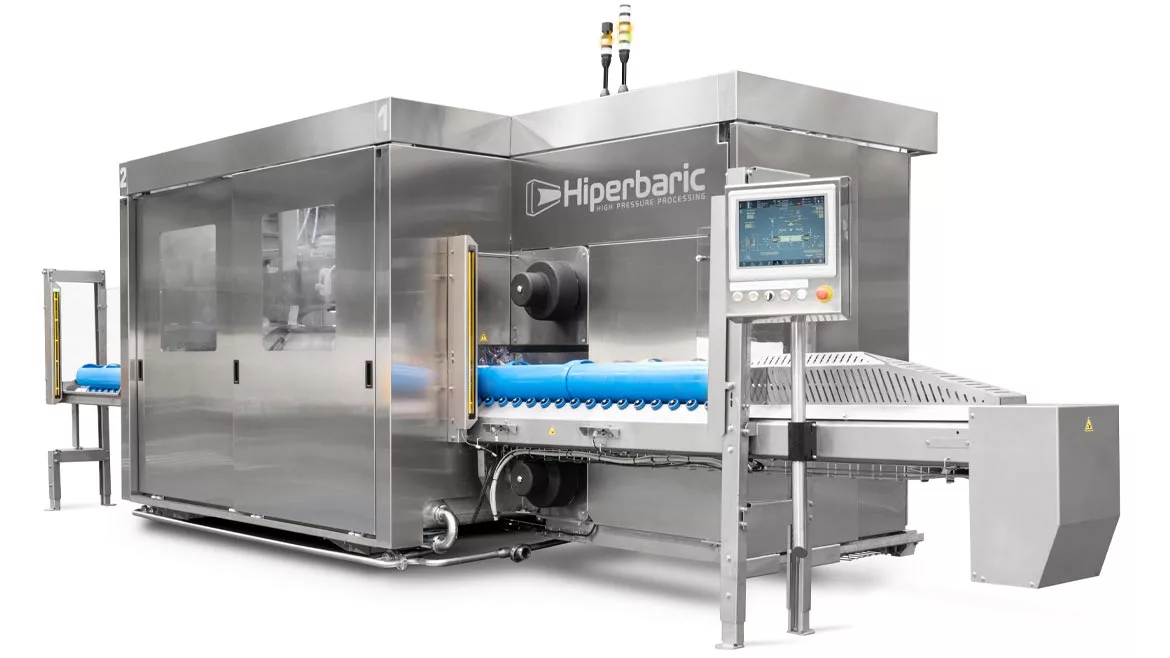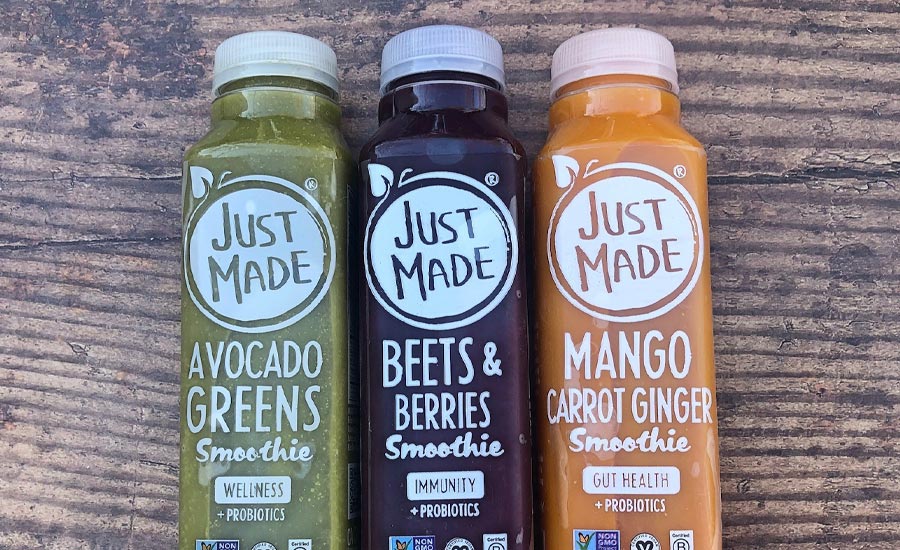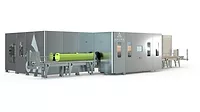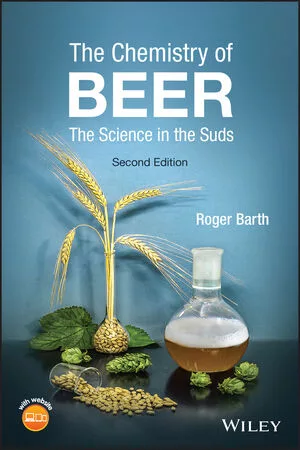Operations
Beverage makers using HPP to provide fresh, natural products
Consumer demand for juices, functional beverages prompts demand for HPP

Image courtesy of Hiperbaric
In the Nickelodeon series “The Fairly OddParents,” 10-year-old Timmy Turner has two fairy godparents named Cosmo and Wanda. The fairy godparents must grant Timmy any wish he desires, and the pair typically help Timmy through day-to-day challenges, though the wishes tend to go awry.
Similar to the way Cosmo and Wanda fulfill Timmy’s wishes, beverage-makers are fulfilling the need states of consumers — but without the wave of a magic wand.
Anthony Zapata, business development, Hiperbaric USA, Miami, Fla., explains how trends in the beverage industry are influencing the rise of high-pressure processing (HPP) technology.
“Consumer demand for premium, cold-pressed, organic juices continues to be strong,” Zapata explains. “Juices and beverages make up about 24% of the food and beverages processed with Hiperbaric HPP equipment.
“Aside from cold-pressed juices, other beverage trends include the development of functional beverages and premium, craft beverages, such as fruit-infused waters and cold-pressed juice mixers for specialty cocktails,” he continues.
Zapata notes that the application of HPP technology has “brought about a significant transformation” in the beverage manufacturing industry.
Several categories of beverages can benefit from HPP technology, Zapata says, such as cold-pressed juices and shots, smoothies, fruit-based waters, functional sport and energy drinks, non-dairy milks, as well as cold brew coffees and teas.
“As the market trends toward functional beverages for their added supplements, vitamins and probiotics, this category is specially positioned to benefit from HPP, as it extends shelf life while maintaining the flavor, color and heat-sensitive nutrients, such as vitamins and bioactives, including enzymes,” he explains.
Beverage manufacturers can benefit from using HPP technology as well. Zapata identifies five benefits driving the increased use of HPP in the beverage industry: the demand for fresh, natural products; clean label, minimal processing appeal; the need for longer shelf life; and preventing food waste.
“Consumers want beverages with minimal processing that maintain a fresh taste,” he says. “HPP allows beverages to be preserved without using heat or chemicals that can alter flavors.”
Furthermore, consumer desire for clean label products has pushed beverage-makers toward HPP. The technology “allows beverage brands to avoid listing preservatives, heat treatment or other processes on their labels,” Zapata says. This is attractive to consumers who are looking for products with minimal processing, he notes.
“Beverage companies want to extend the shelf life of their products while still being able to use natural, fresh ingredients. HPP can extend the shelf life of juices and beverages up to 120 days by inactivating food-borne pathogens, without preservatives,” Zapata explains. “By extending shelf-life, beverage manufacturers have begun processing fruit and vegetables that otherwise would end up in landfills by creating value-added products, such as cold-pressed juice and smoothies.”
Ultimately, Zapata suggests that companies view HPP as a “competitive edge” to meet consumer demand for beverages that are healthier and less processed with longer shelf lives.
Walter Nimocks, CEO and founder of Houston-based Just Made, also points out that consumers are demanding fresh juice.
This demand is obvious from the amount of fresh-pressed juices in grocery stores and juice bars around the country, Nimocks says. Juices are “a convenient and easy way” to attain vital nutrients for a healthy lifestyle, he notes.


Image courtesy of Just Made
“Consumers are walking away from heat pasteurization, because, as we all know, heat destroys flavor, nutrients and color, so manufacturers have to add stuff back in to make it taste good. Most of the time, they’re adding sugar in one form or another, and sugar has been linked to so many chronic health problems in the U.S. and other countries,” Nimocks says. “HPP helps to preserve the flavor, color and naturally occurring nutrients available in fresh fruits and vegetables, and helps to extend shelf lives for up to 60 days or longer.”
As for which beverage categories are likely to take advantage of HPP technology, Nimocks notes that, aside from the fresh-pressed juice category, beverages that are low in pH have potential for development.
“At Just Made Foods, we are eyeing several opportunities outside of fresh juice, which we believe hold potential in the market and will benefit from HPP,” he says.
Tom Woodward, chief commercial officer at Lincoln, Neb.-based Universal Pure, also credits consumer desire for cleaner labels and functional beverages as influences on HPP technology.
“Consumers are seeking fresh and natural products with fewer or no preservatives and clean ingredient statements,” Woodward notes. “They are also looking for beverage options that fit their lifestyles and provide healthy options.”
From a brand and retailer perspective, he says that HPP is “complementary” with beverage trends that are health-oriented, because is addresses the need for products to have a longer shelf-life while ensuring that brands provide a product that is clean-label.
“Fresh, premium beverages naturally have a limited shelf-life without any additives or preservative measures,” Woodward explains. “HPP technology increases shelf-life through the combination of water and pressure, inactivating microorganisms that could cause product spoilage, without the need for thermal processing or preservatives.”
He says that HPP technology is being adopted by brands for premium beverage products, with a growing number of brands turning to HPP for its benefits to provide “fresh juices and smoothies, cold brew coffees and teas, plant-based protein drinks, dairy-based beverages, and juice-based functional shots.”
In terms of benefits for manufacturers, Woodward suggests that those already using HPP technology understand the shelf-life and food safety benefits provided by this technology. There are ROI and sustainability benefits associated with HPP.
“Because of the extended shelf-life, beverage products that undergo HPP can travel long distances across the cold chain and reach retail shelf with sufficient shelf life to avoid product shrink and waste,” he explains. “Desirable shelf-life is often a major hurdle for beverage manufacturers as they pitch their product to retail stores — minimum shelf-life expectations can limit a brand’s chances of getting on the shelf.”
Woodward says that HPP technology can help manufacturers overcome this challenge, as well as support small brands as they drive the growth of their business.
Making moves
When it comes to advancements in HPP technology, Hiperbaric’s Zapata indicates automation as one of the biggest advancements.
“Evolution Fresh, a Bolthouse Farms subsidiary, uses Hiperbaric automation equipment to HPP its cold-pressed juices,” he notes. “The company reports the following benefits, including 15% improvement in overall equipment effectiveness, 90% reduction in injuries, 50% reduction in transportation waste and 50% reduction in line labor.”
Because it’s a post-packaging process, HPP requires the manual process of loading packaged products into baskets, Zapata notes.
“Pre-feeder stations and robotic load and unload solutions allow manufacturers to improve processing efficiencies, while reducing potential manual labor injuries from repetitive movements, heavy lifting and costs,” he explains.
In-bulk technology has been another advancement for HPP. Hiberbaric’s In-Bulk technology is a global innovation for high volume processing of HPP beverages, Zapata explains.
“This equipment is based on a revolutionary concept in which beverages are processed in-bulk prior to bottling,” he says. “The technology reduces manufacturing steps and offers high productivity, with low processing and energy costs.”
He notes that the design permits a filling efficiency of 90% of the total volume, “about double that of traditional in-pack technology.” After liquid filling an inlet tank, the process continues after pressurization. The HPP beverage then fills the outlet tank through sterilized tubes and is ready to be bottled in an “ultra-clean filling line,” Zapata says. Plus, any type of bottling packing can be used, he notes.
An additional innovation in HPP technology, according to Zapata, is juice on tap.
“Hiperbaric has recently partnered with a company called Petainer, which provides one-way PET recyclable kegs that can be HPP’d,” he says. “This allows juice manufacturers to dispense juice on tap at grocery stores, festivals, trade shows and other events.”
Universal Pure’s Woodward points to larger capacity equipment and the expansion of a national HPP outsources and co-packing network as noteworthy advancements. The national network gives beverage brands of all sizes the opportunity to leverage HPP with a limited capital expense, he explains.
“For example, at Universal Pure, we have expanded our HPP capacity and footprint to include seven strategically located facilities across the United States,” he says. “This development enables brands to regionally access HPP and reach markets that previously would have been challenging to adequately service.”
Considering the cost
Beverage manufacturers must take cost and return on investment (ROI) factors into account when looking into HPP purchases.
Just Made’s Nimocks notes that, because HPP is a batch process, it takes more time and is more costly than continuously running liquid through a heated pipe. He adds that there are a handful of HPP facilities around the country that will process for smaller companies.
“The real benefits are realized when an HPP machine is installed in-house,” Nimocks says. “Costs go down, quality and inventory control all improve with having an HPP in-house. The cost of a machine is substantial, and the infrastructure to install one can be pricey, especially today with rising construction costs and long lead times, but if the volume is there, then the payback can be just a few short years.”
Hiperbaric’s Zapata goes on to say that many companies use tollers, or a third-party HPP service provider if the company decides not to purchase an HPP machine outright.
Using a toller allows companies to focus on other aspects of business, and also can give companies time to test new product concepts, Zapata says.
“Still, others prefer to purchase their own HPP machine if they have committed to using HPP in their business, want to control all aspects of the business and have the space and resources their own machine,” he explains.
He points to the Hiperbaric 55 as being “the perfect first step into the HPP business,” with a 55-liter vessel and a 200-millimeter diameter. Zapata says the design is robust and compact, making it easy and quick to install in almost any facility.
Universal Pure’s Woodward also says that beverage manufacturers should consider the costs between purchasing their own equipment and outsourcing the services. He estimates that HPP equipment alone can reach or exceed $3-4 million.
“This investment does not include auxiliary equipment like conveyors, dryers and ink-jet machinery, or the cost of factory floor reinforcement to support the weight and operation of HPP equipment,” Woodward explains. “Additionally, brands should consider the manpower requirements of an HPP line, which includes line operators for loading and unloading, re-packing, et cetera, as well as HPP maintenance technicians.”
Furthermore, he says that there are “ongoing costs” for spare and replacement parts, in addition to machinery/operational downtime during maintenance periods. In comparison, third-party providers are responsible for costs associated with additional equipment, labor and maintenance, he notes.
“Outsourcing HPP services allows brands to focus on their product, branding and ROI, without the worry of costly demand, labor or machinery disruptions.”
What’s on the horizon for HPP
Although it’s difficult to predict exactly what is next for HPP, Just Made’s Nimocks says he would like to see further development with semi-continuous flow HPP machines.
“With that, I mean machines that can be operated nearly continuously and hold liquids in a sanitized tank for filling,” he explains. “There have been attempts to solve this problem by one manufacturer, and we traveled to Europe late last year to see a machine that is using this technology, but the runs were prohibitively long for our products.”
Because Just Made has more than 20 SKUs, Nimocks says the machine in Europe did not make sense for the company, as they must operate with shorter runs.
“This technology also offers the option to fill in environmentally friendly containers,” he adds. “While PET can be recycled, many consumers desire packaging that is compostable or biodegradable. We would definitely like to see equipment manufactures focus more resources on addressing this problem.”
Hiperbaric’s Zapata suggests that new beverage categories will impact HPP, such as artisanal, non-pasteurized beer with a shelf life of 90-plus days without the requirement of maintaining the cold chain.
Also, rPET sustainable bottle packaging compatible with HPP is something to consider, Zapata notes
“By incorporating rPET into your product mix, you can reduce your carbon footprint, decrease fossil fuel consumption and contribute to the advancement of a circular economy, where all plastic is collected, reprocessed and reused,” Zapata says. “The circular economy is the ultimate vision for long-term sustainability, and with rPET, we can help make this a reality while preserving recyclability and adding value to recycled PET.”
Universal Pure’s Woodward considers the benefits of HPP to be unmatched, and says that brands looking to be competitive in the retail space should utilize HPP for its go-to preservation and food safety methods.
“As consumers and brands continue to be aware of health and wellness, as well as sustainability and the environment, the demand for fresh, functional beverages will continue to rise,” he notes. “HPP technology will continue to grow as beverage manufacturers realize the premium positioning, competitive advantage and ROI achieved through HPP.”
Looking for a reprint of this article?
From high-res PDFs to custom plaques, order your copy today!







